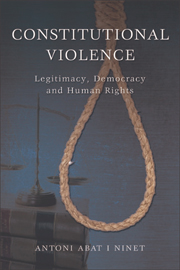5 - Comparing Constitutional Violence
Published online by Cambridge University Press: 05 August 2013
Summary
MAINTAINING AND FOUNDATIONAL CONSTITUTIONAL VIOLENCE
Doctrinae quidem verae esse possunt; sed auctoritas, non veritas, facit legem.
This chapter is an empirical demonstration of current constitutional violence and how symbolic and theoretical constitutional violence affects people. It examines comparative constitutional violence and legal realism, and it shows why constitutional violence is important and looks at the theory and the practice.
The chapter begins with an example of American constitutional violence based on the application of the death penalty in Puerto Rico: in contravention of the articles of the Puerto Rican Constitution; the expressed will of the people; the declared position of Puerto Rico's elected politicians (governor, senate and municipalities); and, finally, in contravention of international human rights conventions. American constitutional violence is inflicted on Puerto Rico in two different ways: first, through the application of an extradition clause in the American constitution (inter-state rendition clause), which provides for the extradition of a criminal back to the state where he or she has committed a crime; and, second, through the enforcement of capital punishment on Puerto Rican soil, in contravention of the will of the people of Puerto Rico and the constitution of the Commonwealth of Puerto Rico. In both examples the American constitution is violently enforced.
- Type
- Chapter
- Information
- Constitutional ViolenceLegitimacy, Democracy and Human Rights, pp. 114 - 170Publisher: Edinburgh University PressPrint publication year: 2012



